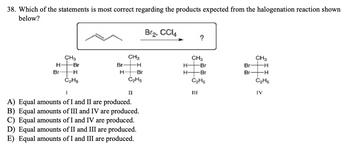
Chemistry
10th Edition
ISBN: 9781305957404
Author: Steven S. Zumdahl, Susan A. Zumdahl, Donald J. DeCoste
Publisher: Cengage Learning
expand_more
expand_more
format_list_bulleted
Concept explainers
Question

Transcribed Image Text:38. Which of the statements is most correct regarding the products expected from the halogenation reaction shown
below?
H
Br
CH3
-Br
-H
C₂Hs
Br
H
CH3
-H
-Br
C₂H5
1
A) Equal amounts of I and II are produced.
B) Equal amounts of III and IV are produced.
C) Equal amounts of I and IV are produced.
D) Equal amounts of II and III are produced.
E) Equal amounts of I and III are produced.
II
Br₂, CCI4
H-
?
CH3
Br
H-Br
C₂H5
Br
Br
CH3
H
-H
C₂H5
IV
Expert Solution
This question has been solved!
Explore an expertly crafted, step-by-step solution for a thorough understanding of key concepts.
Step by stepSolved in 3 steps with 1 images

Knowledge Booster
Learn more about
Need a deep-dive on the concept behind this application? Look no further. Learn more about this topic, chemistry and related others by exploring similar questions and additional content below.Similar questions
- 1. Consider the reaction: 3A + 5B + 1C – 2D + 1E THal C If you have 6 moles of reactant A and excess of B and C, how much product E would be formed? (Show your work).arrow_forwardWhat is the product of this reaction? 1) Mg then CO2 2) МеОН, Н2SO4 Br HO, MeO OMe OMe OMearrow_forwardHow many moles of O2 are formed from 3.0 moles of KClO3? 2KClO3 → 2KCl + 3O2arrow_forward
- Which of the compounds below is/are possible product(s) for the following reactions? Br CH;CH,OH %3D II IV O l and II O l and II O I, II, II, and IV O l and IVarrow_forward2 C2H4 + 6 O2 --> 4 CO2 + 4 H2O From the above reaction, how many moles of O2 are required for the complete combustion of 44.88 g of C2H4? a. 1.3 ×102 mol b. 3.00 mol c. 4.8 mol d. 11.25 molarrow_forwardcreate a potential energy diagram for H-H+CI-CI--->H-CI+H-CI Label the products, reactants, ∆H, and determine whether the reaction is exothermic or endothermic.arrow_forward
arrow_back_ios
arrow_forward_ios
Recommended textbooks for you
 ChemistryChemistryISBN:9781305957404Author:Steven S. Zumdahl, Susan A. Zumdahl, Donald J. DeCostePublisher:Cengage Learning
ChemistryChemistryISBN:9781305957404Author:Steven S. Zumdahl, Susan A. Zumdahl, Donald J. DeCostePublisher:Cengage Learning ChemistryChemistryISBN:9781259911156Author:Raymond Chang Dr., Jason Overby ProfessorPublisher:McGraw-Hill Education
ChemistryChemistryISBN:9781259911156Author:Raymond Chang Dr., Jason Overby ProfessorPublisher:McGraw-Hill Education Principles of Instrumental AnalysisChemistryISBN:9781305577213Author:Douglas A. Skoog, F. James Holler, Stanley R. CrouchPublisher:Cengage Learning
Principles of Instrumental AnalysisChemistryISBN:9781305577213Author:Douglas A. Skoog, F. James Holler, Stanley R. CrouchPublisher:Cengage Learning Organic ChemistryChemistryISBN:9780078021558Author:Janice Gorzynski Smith Dr.Publisher:McGraw-Hill Education
Organic ChemistryChemistryISBN:9780078021558Author:Janice Gorzynski Smith Dr.Publisher:McGraw-Hill Education Chemistry: Principles and ReactionsChemistryISBN:9781305079373Author:William L. Masterton, Cecile N. HurleyPublisher:Cengage Learning
Chemistry: Principles and ReactionsChemistryISBN:9781305079373Author:William L. Masterton, Cecile N. HurleyPublisher:Cengage Learning Elementary Principles of Chemical Processes, Bind...ChemistryISBN:9781118431221Author:Richard M. Felder, Ronald W. Rousseau, Lisa G. BullardPublisher:WILEY
Elementary Principles of Chemical Processes, Bind...ChemistryISBN:9781118431221Author:Richard M. Felder, Ronald W. Rousseau, Lisa G. BullardPublisher:WILEY

Chemistry
Chemistry
ISBN:9781305957404
Author:Steven S. Zumdahl, Susan A. Zumdahl, Donald J. DeCoste
Publisher:Cengage Learning

Chemistry
Chemistry
ISBN:9781259911156
Author:Raymond Chang Dr., Jason Overby Professor
Publisher:McGraw-Hill Education

Principles of Instrumental Analysis
Chemistry
ISBN:9781305577213
Author:Douglas A. Skoog, F. James Holler, Stanley R. Crouch
Publisher:Cengage Learning

Organic Chemistry
Chemistry
ISBN:9780078021558
Author:Janice Gorzynski Smith Dr.
Publisher:McGraw-Hill Education

Chemistry: Principles and Reactions
Chemistry
ISBN:9781305079373
Author:William L. Masterton, Cecile N. Hurley
Publisher:Cengage Learning

Elementary Principles of Chemical Processes, Bind...
Chemistry
ISBN:9781118431221
Author:Richard M. Felder, Ronald W. Rousseau, Lisa G. Bullard
Publisher:WILEY